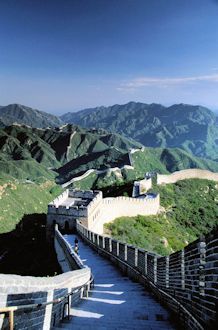
|
Emperor Qin Shihuang - Scene 4
Qin Shihuang
The Emperor's burial complex covers seven square miles and the tomb itself is
as large as a football field. It includes over 8,000 figures, with everything
from the terracotta army, assembled to protect the emperor from his spiritual
enemies, to musicians and court officials, full-scale pleasure gardens
(complete with replica bronze birds), entertainers and acrobats.
Skeletons of courtiers have recently been discovered - one is believed to be
his eldest son, executed by his opponents shortly after the emperor's death.
The evidence: a crossbow bolt discovered embedded in the skull.
Two thousand years after the Emperor's death, archaeological exploration,
including ground-penetrating radar, shows the actual shapes, layout, and design
of various tomb structures inside the tomb mound, including the structure of
the tomb itself buried beneath the pyramid and covered with millions of tons of
earth. This is recreated for the film using cutting-edge computer graphics.
For the first time, earth core samples are taken off the tomb mound and
analyzed. The testing proves that there were rivers of mercury inside the
tomb, laid out in the shape of a map of China. At the time, mercury was
believed to prolong life.
Following a huge battle with the state of Ch'u, Ying Jien achieved his ultimate
dream by 223 BC - the unification of all of China. At the age of 34, Ying Jien
became China's first emperor, and re-named Emperor Chin Shi Huang Di, -
literally meaning "the first divine god of the Chin". To the shock of his
court, the new emperor disbanded feudal order and instead created a new system
of government - a totalitarian philosophy that created rules for every part of
every citizen's daily life, overseen by a series of governors, enforced with
brutal efficiency.
|
